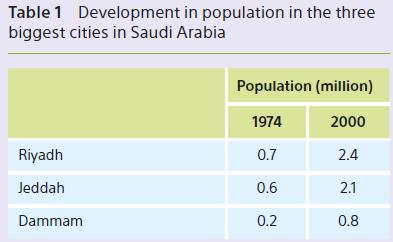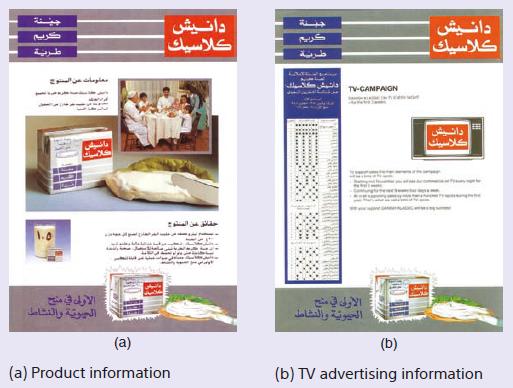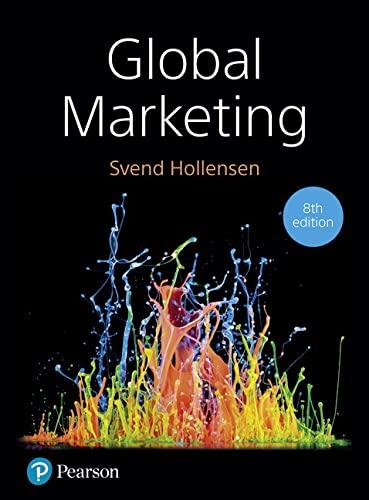In the spring of 1987, the product manager of Danish Cheese Overseas, KA, was pleased to note
Question:
In the spring of 1987, the product manager of Danish Cheese Overseas, KA, was pleased to note that after some decline (e.g. in Iran) feta sales were improving in the Middle East. However, the company was a little concerned that the feta, according to several expert opinions, could lose ground to a cream cheese that was apparently becoming more and more popular among Arabs in both the cities and provincial areas.
Saudi Arabia in general Because of its immense income from oil, Saudi Arabia had developed fantastically over the previous 30 years. With Islamic tradition as its basis, the country had become more international. In 1987, the population was 11.5 million, more than 50 per cent of whom were under 15 years of age, making Saudi Arabia a ‘young’ nation. The Saudi Arabian Ministry of Agriculture had forecast that the population would rise to 19 million by 2000. The expected development in population in the three biggest cities at that time is shown in Table 1.

The cheese market in Saudi Arabia
Traditionally Danish Cheese Overseas had had a strong position in Saudi Arabia, having been the market leader for several years, especially as regards feta and some other types of cheese. However, Danish Cheese Overseas had encountered some difficulties in the cream cheese market. The market had risen, but up to that point two large global exporters of cheese had dominated it – France and Australia.
The total import of cheese into Saudi Arabia in 1986 (there was very little local production) is shown in Table 2. The share of cheese from Denmark at that time was about 25 per cent (£10 million). On the basis of this, Danish Cheese decided to develop a new cream cheese in order to compete with the big exporters of cheese within the cream/processed segment. The product was to be targeted at the Middle East, where Saudi Arabia was the main market, but was also to form the basis of an international brand: Danish Klassic.
In order to plan the specific details of the product parameter, Danish Cheese contacted an international market research bureau that specialized in the Middle East. The objective was to analyse the cream cheese consumption among typical Middle East families living in cities. The final result showed that between 85 and 100 per cent of all family members ate cream cheese on a regular basis (mostly in the middle of the day), and that consumption was especially high among children. Different product concepts were tested among typical families, and the outcome was a 200g cream cheese in brick cartons. This was a new type of packaging – until then cream cheese had mostly been sold in glass packaging.
Marketing plan for Danish Klassic
The following describes the launch actually made by Danish Cheese Overseas in 1987.
An introduction was held in October of that year, in the form of three trade seminars in the largest cities – Riyadh, Jeddah and Dammam.
Here the product concept and the advertising campaign were presented to a large number of distributors and wholesalers (see photos a–e).

TV commercials
In Saudi Arabia, television is considered the most effective medium for mass communication. It therefore became the foundation of the company’s marketing.
In total, 128 commercial spots were planned for the first year (photo b).
Print advertisements
• Consumer-oriented: the most popular newspapers and family magazines in the big cities, especially directed at women as the decisive buyer unit (photo c).
• Distributor-oriented: trade magazines.
• In-store promotion: displays, taste sample demonstrations, etc. (photo d).
The campaign material was introduced in both Arabic and English.


The campaign was influenced by a high degree of pull strategy (consumer influence). In this way, distributors were induced to build up stocks in order to meet the expected end-user demand. The risk the distributors would face when buying large quantities was limited because the cheese could be kept for a year without being refrigerated......
Questions
1. What might have been the reasons that Danish Klassic was not able to meet expectations? Comment on the following:
(a) the change of packaging – from glass to plastic brick carton;
(b) the consumer-oriented advertisement (photo
a) – is it targeted at the Saudi Arabian market?
2. What do you think of the brand name Danish Klassic?
Postscript
On 30 September 2005, the Jyllands-Posten published an article entitled ‘Muhammeds ansigt’ (‘The face of Muhammad’). The article consisted of 12 cartoons, some of which depicted Muhammad.
In late 2005, the Muhammad cartoon controversy received only minor media attention outside of Denmark. Six of the cartoons were reprinted in the Egyptian newspaper El Fagr in October 2005, along with a highly critical article, but publication was not considered noteworthy. January 2006, saw some of the pictures reprinted in Scandinavia, then in major newspapers of Denmark’s southern neighbours Germany, Belgium and France. Soon after this, as protests grew, the cartoons were reprinted around the globe, but mostly in continental Europe. Several

editors in the Middle East were fired for their decision, or even their intention, to republish the cartoons.
Critics of the cartoons argued that they were blasphemous to people of the Muslim faith.
Organized boycotts of Danish goods began in several Islamic countries. In Saudi Arabia, people called for a boycott on Danish products on 20 January 2006 and carried it out from 26 January. The boycott primarily targeted dairy products produced by Arla Foods, but also hit other products such as Bang & Olufsen and LEGO. The Foreign Minister of Denmark, Per Stig Møller, stated that the boycott had not been initiated by the Saudi Arabian government. The dairy company Arla Foods launched a massive ad campaign in Saudi Arabia, aiming to improve its reputation and stop the boycott. This happened after sales in Saudi Arabia came to an almost complete stop. Arla’s exports to Saudi Arabia were almost €380 million a year. Arla halted production in the Saudi capital Riyadh and sent home 170 employees. Denmark was concerned about the potential loss of 11,000 jobs resulting from boycotts against Danish products in the Islamic world.
However, during 2008 and 2009 the situation eased and by the end of 2009 and forward the sales of Arla products were again above the level for the Middle East region (compared to before the Muhammad cartoons).
Step by Step Answer:






